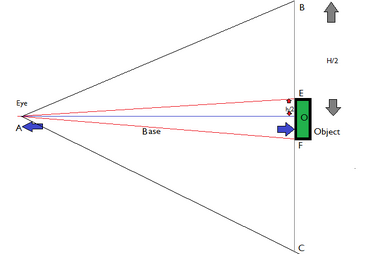So I managed to remember the maths I did

In the above
very rough diagram, H is panel height (BC), h is object height (EF). The angle BAO will be half of a human eye's range of view (The range is 70 degree I believe).
In triangle BAO,
-Tan 70/2=(H/2)/Base
In triangle EAO
-Tan(x/2)=(h/2)/Base
If we divide the two equations
-h/H=Tan(x/2)/Tan(70/2)
Bringing tan70/2 to the left side
-Tan(70/2)*(h/H)=tan(x/2)
Using inverse
-Tan-1{Tan(70/2)*(h/H)}=x/2
-Or 2Tan-1{Tan(70/2)*(h/H)}=x
x is the angle you are supposed to find